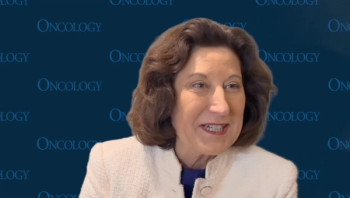
Apatinib Plus Pegylated Liposomal Doxorubicin Yields Significant Efficacy in Advanced Ovarian Cancer
Results from the phase 2 APPROVE trial showed apatinib plus pegylated liposomal doxorubicin improved efficacy and safety compared with pegylated liposomal doxorubicin alone for patients with platinum-resistant recurrent ovarian cancer.
Treatment with apatinib (Rivoceranib) plus pegylated liposomal doxorubicin (PLD) vs PLD alone showed improved efficacy with a manageable safety profile for patients with platinum-resistant recurrent ovarian cancer, according to results from the phase 2 APPROVE trial (NCT04348032).
At the median follow-up of 8.7 months, the median progression-free survival (PFS) was 5.8 months (95% CI, 3.8-8.8) in the apatinib arm compared with 3.3 months (95% CI, 2.1-3.8) for PLD alone (HR, 0.44; 95% CI, 0.28-0.71; P <.001). The median overall survival (OS) in the apatinib arm was 23.0 months (95% CI, 18.9–not reached) compared with 14.4 months (95% CI, 12.1-23.4) in the PLD alone arm (HR, 0.66; 95% CI, 0.40-1.09; P = .10).
A total of 152 patients were enrolled and randomly assigned to either the apatinib arm (n = 78) or the PLD alone arm (n = 74). A progression event or death was experienced in 47.4% of patients in the apatinib group and 67.6% in the PLD alone arm.
PLD was given at 40 mg/m2 on day 1 every 4 weeks for up to 6 cycles in both groups. Apatinib was given at 250 mg once daily.
The objective response rate was observed in 83.3% of patients in the apatinib group and 86.5% in the PLD alone group. Additionally, an unconfirmed objective response was observed in 43.1% of patients in the apatinib group (95% CI, 30.8%-56.0%) and 10.9% (95% CI, 4.5%-21.2%) in the PLD alone group (rate difference, 31.6%; 95% CI, 17.2%-46.1%). In the apatinib group, a disease control rate of 81.5% (95% CI, 70.0%-90.1%) in the apatinib group was observed vs 53.1% (95% CI, 40.2%-65.7%) in the PLD alone group (rate difference, 28.9%; 95% CI, 13.5%-44.4%).
In the apatinib group, the median time to response was 2.1 months (95% CI, 1.8-2.3), as well as 2.1 months (95% CI, 1.8-3.5) in the PLD alone group. Additionally, of those who possessed measurable lesions and underwent at least 1 post-baseline imaging assessment, 87.8% in the apatinib group and 39.2% in the PLD alone group had target lesion reduction.
For patients receiving PLD, the median dose intensity was 96% in the PLD alone group and 98% in the apatinib group, and the median relative dose intensity was 100% for apatinib. Apatinib dose reductions were necessary in 12.2% of patients and 6.8% required PLD dose reductions. At least 1 dose interruption was noted in 29.7% of patients overall. In the apatinib group, 3.8% of patients discontinued treatment because of adverse effects (AE).
At least 1 treatment-emergent AE (TEAE) was observed in 93.2% of patients in the apatinib group and 84.7% in the PLD alone group. The most common TEAEs were decreased white blood cell count (60.8% vs 50.0%) and decreased neutrophil counts (59.5% vs 37.5%) in the apatinib and PLD alone groups, respectively.
Those treated with apatinib had an increase in any-grade hand-foot syndrome (25.7% vs 2.8%), hypertension (17.6% vs 1.4%), and proteinuria (14.9% vs 2.8%) compared with the PLD alone group. The most common TEAEs of grade 3 or higher included decreased neutrophil counts (14.9% vs 8.3%), hypertension (8.1% vs 0.0%), and decreased white blood cell counts (6.8% vs 4.2%) between the apatinib and PLD alone group, respectively.
Serious AEs included 12.2% of patients in the apatinib arm, with the most common being incomplete bowel obstruction (2.7%) and intestinal fistula (2.7%). Moreover, 4.2% of patients in the PLD alone group experienced 1 instance each of infection, vomiting or nausea, and acute pancreatitis. No patients died from AEs.
Reference
Wang T, Tang J, Yang H, et al. Effect of apatinib plus pegylated liposomal doxorubicin vs pegylated liposomal doxorubicin alone on platinum-resistant recurrent ovarian cancer: the APPROVE randomized clinical trial. JAMA Oncol. Published Online June 30, 2022. doi:10.1001/jamaoncol.2022.2253
Newsletter
Stay up to date on recent advances in the multidisciplinary approach to cancer.
















































































